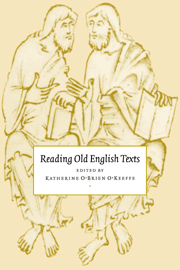Book contents
- Frontmatter
- Contents
- List of contributors
- List of abbreviations
- Note on the text
- Introduction
- 1 The comparative approach
- 2 Source study
- 3 Language matters
- 4 Historicist approaches
- 5 Oral tradition
- 6 The recovery of texts
- 7 At a crossroads: Old English and feminist criticism
- 8 Post-structuralist theories: the subject and the text
- 9 Old English and computing: a guided tour
- Suggestions for further reading
- Index
2 - Source study
Published online by Cambridge University Press: 18 December 2009
- Frontmatter
- Contents
- List of contributors
- List of abbreviations
- Note on the text
- Introduction
- 1 The comparative approach
- 2 Source study
- 3 Language matters
- 4 Historicist approaches
- 5 Oral tradition
- 6 The recovery of texts
- 7 At a crossroads: Old English and feminist criticism
- 8 Post-structuralist theories: the subject and the text
- 9 Old English and computing: a guided tour
- Suggestions for further reading
- Index
Summary
Nowadays originality in art is considered a desirable quality, but in earlier centuries it was less significant. From ancient times artists consciously borrowed one another's ideas, a practice endorsed by critics from Aristotle onwards. The study of a writer's sources has for two centuries been a widely accepted means of understanding the workings of his or her mind, for in selecting, reorganizing and modifying ideas from earlier writers, authors display their own particular cast of thought. Most of the identifiable sources used by Anglo-Saxon writers are in Latin, and the change of language in itself may be revealing. At the very simplest level of translation, the choice of particular words or phrases to express those in the original reveals much about the meaning of Old English lexical items (for which, it must always be remembered, we have no native informants), about individual Anglo-Saxons' understanding of the meaning of Latin terms, about the range of synonyms and collocations available in English, and about ways that Anglo-Saxon authors found of conveying concepts foreign to England and the English. As we move further from literal translation to the incorporation of the ideas of a written source into the thought processes of a native writer, we gain ever more valuable, if often less tangible, evidence of the intellectual and more widely cultural climate of Anglo-Saxon England, and at the same time increase our understanding of the intricate structure of the literature and its web of imagery.
- Type
- Chapter
- Information
- Reading Old English Texts , pp. 39 - 58Publisher: Cambridge University PressPrint publication year: 1997
- 3
- Cited by

